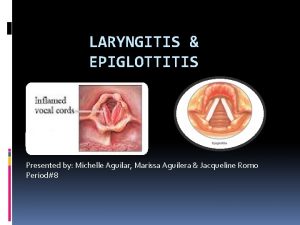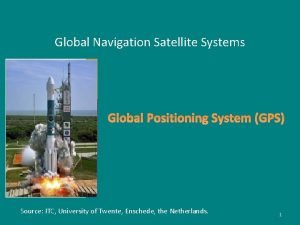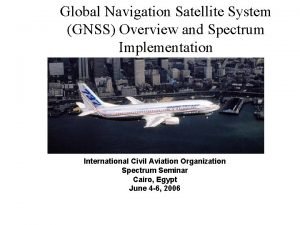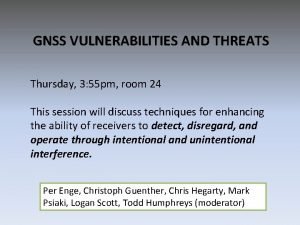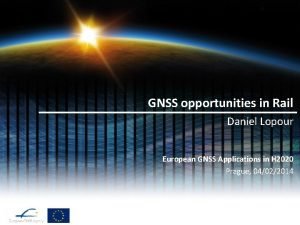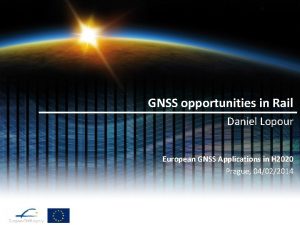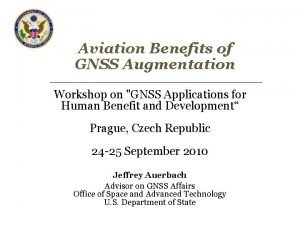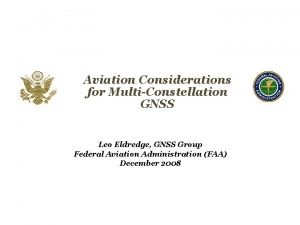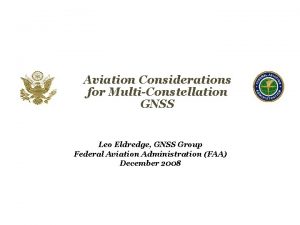GNSS opportunities in aviation Carmen Aguilera European GNSS










- Slides: 10

GNSS opportunities in aviation Carmen Aguilera European GNSS Applications in H 2020 Prague, 04/02/2014

GNSS penetration GNSS is expected to reach over 90% penetration by 2022 as an enabler of Performance Based Navigation Key market trends: • Transition from traditional routing to GNSS navigation solutions for all phases of flight. • New operational requirements driving the growth of GNSS avionics use. • Growing availability of SBAS-based procedures in European aerodromes. 09 -Nov-20 European GNSS Agency 2

EGNOS and Galileo added value Exploring E-GNSS potential for Communication, Navigation and Surveillance for all phases of flight EGNOS is there, use it! ü Enabler of Performance Based Navigation, in particular APV SBAS approaches ü Increases safety, and delivers operational benefits ü Technology enabler of SESAR Galileo contribution to safer global aviation: ü Interoperability with other GNSS ü Multiconstellation/multifrequency enables more robustness against vulnerabilities ü Contribution to Ground-Based Augmentation System (GBAS)

Current status of the EGNSS adoption in aviation (I): States shared plans show growth by 2018 for procedures As of 22 nd Jan 2014 Plans by 2018 95 LPV serving 70 airports (+91 ‘EGNOS enabled’ APV Baro serving 41 airports) >440 LPV planned by 2018 Map source: EUROCONTROL PBN Map Tool 4

Current status of the EGNSS adoption in aviation (II): EU airspace users get EGNOS onboard

Target Market segments: opportunities and challenges Business aviation General aviation • Fastest growing market in Europe • Largest market in number of users (low margins) • Most aircraft OEM forward fit EGNOS capability • Price sensitive • • Major EGNOS benefit is safety due to increased situational awareness. Pro-active in requesting advanced SBAS procedures, since aircraft have the required operational capability • EGNOS increases accessibility to small airports also in bad weather conditions • Mandates on P-RNAV may increase motivation Regional aviation Helicopters • More likely to fly LPV than APV Baro procedures • Regulatory framework starting • Expensive retrofit • • EGNOS provides access to smaller aerodromes in poor weather conditions Pin. S* LPV criteria publication by ICAO expected in Nov 2014 • EGNOS provides access to non-ILS equipped aerodromes European OEM forward-fitting certain types (Augusta Westland Eurocopter) • Flight trials and procedures deigned in FP 7 • *Pin. S: Point in Space 6

Areas of interest for GNSS research in aviation Fostering EGNOS adoption in aviation ü Enablers/Tools/methodologies to facilitate LPV implementation ü Bring LPV to small aerodromes ü Extend knowledge and benefits to new users ü Increase helicopters adoption Challenges and opportunities ahead Need • Explore E-GNSS potential for Communication, Navigation and Surveillance for all phases of flight • Get ready for LPV-200 capability (ready by 2015) • Advanced operations using GNSS as enabler (4 D) • Get ready for multiconstellation/multifrequency solutions 7

Thank you! We are looking forward to your ideas Carmen Aguilera Carmen. aguilera@gsa. europa. eu

Discussion • The call asks for a business plan, but implementation of new operations in aviation take very long time. How can we be compliant? – Consider business plan in a broad sense: demonstrate the added value of your project for aviation users, also in the medium or long term • There are no multiconstellation multifrequency receivers in the market yet (e. g. for EGNOS V 3). Does it fit in the call? – No, this is an application focused call, receivers will be covered by different activities • Does the GSA envisage cooperation with SESAR? – Absolutely, cooperation is in place. EGNOS is a technology enabler for SESAR and a lot of development on Galileo (GBAS) is ongoing. Proposals aligned with SESAR roadmap are welcome, although without overlapping! – 09 -Nov-20 European GNSS Agency 9

Aviation Value Chain and main trends Device Manufacturers Market Trends Examples of key players Main Players (CA/RA): Honeywell (US) Rockwell Collins (US) Thales Avionics (FR) Universal (US) Main Players (BA/GA): Aircraft Manufacturers Main Players (CA/RA): Airbus (EU) Boeing (US) Embraer (BR) ATR (EU) Main Players (BA/GA): Cessna (US) Garmin (US) Bombardier (US) Honeywell (US) Cirrus (US) Rockwell Collins (US) Piper (US) Dassault Aviation (EU) The capabilities of GNSS devices respond to customer demand fit within the regulatory environment. The VFR segment is seeing a proliferation of devices integrating GNSS tailored for the segment. New features and capabilites from regulated devices are expected to align with the requirements of PBN and the progression towards multifrequency integration. Aircraft manufacturers continue to offer avionics provided by a chosen set of manufacturers due to cost and certificiation implications of making more options widely available. This limitation does not exist for VFR pilots which can make choices purely on cost and personal preference. GNSS is included as standard on all modern aircraft. SBAS capability as standard is currently dominiated by Business and General Aviation. The availability of new capabilities needs to be driven back to equipment manufacturers based on user demand. Airspace users Main airline alliances: Oneworld Sky. Team Star Alliance Aircraft Owners and Pilots Association (AOPA) European Regional Airlines association (ERA) International Air Transport Association (IATA) The market demands of the different users varies significantly. Demand for GNSS in particular ENGOS - is from users that fly to less equipped airfields where precision approach capabilities may not exist. The move to implement PBN is expected to result in more operators having to retrofit GNSS and SBAS capabilities. It is expected that some operators will delay upgrades for as long as possible. There is an expectation that the availability of GBAS CAT II and CAT III will prompt further interest from Commerical Aviation. Air Navigation Service Providers (ANSP) Aerodromes Main Categories: International airports Regional airports Private aerodromes Heliports Main Organisations: • The Civil Air Navigation Services Organisation (CANSO) represents ANSPs Regulatory bodies • The International Civil Aviation Organisation (ICAO) codifies the principles of air navigation ANSPs are moving towards the deployment of PBN operations within the en-route and terminal phases of flight. The extention of PBN approaches to the aeordrome may fall within the remit of. ANSPs but tends to be driven by the aerodromes. It is expected that as PBN operations become more common place and multifrequency GNSS becomes available that ANSPs will begin looking at rationalising the traditional navigation infrastructure. Regional and private aerodromes are driving the uptake of GNSS approaches as a means to offer near precision approach capabilites for significantly reduced costs. Small airfields with limited infrastructure can potentially benefit from SBAS. International aerodromes tend to retain precision approaches and are served primarily by commercial airlines looking to use APV approaches that do not require extensive retrofits. These aerodromes will look to deploy GBAS CAT II and III when available. 10



